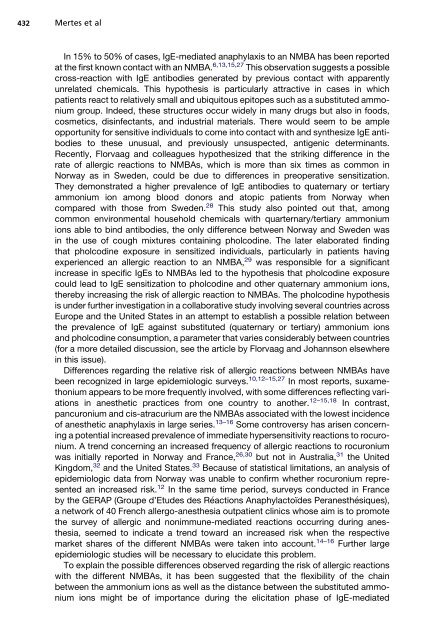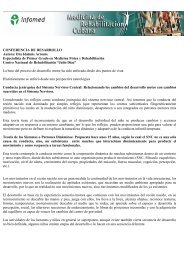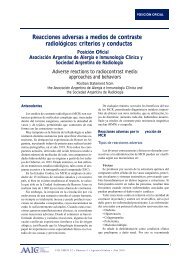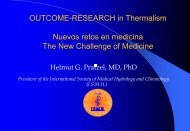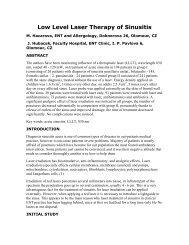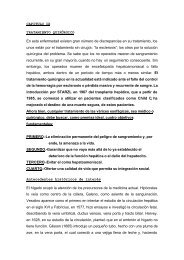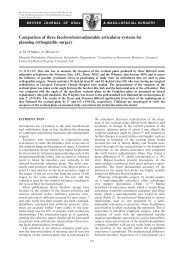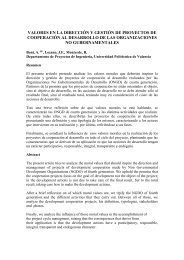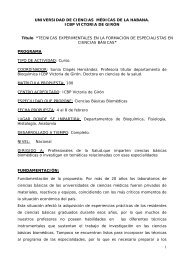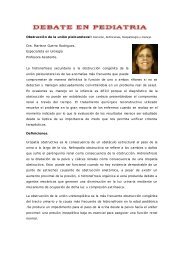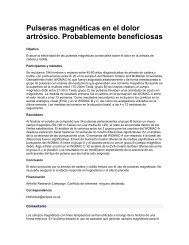Perioperative Anaphylaxis
Perioperative Anaphylaxis
Perioperative Anaphylaxis
You also want an ePaper? Increase the reach of your titles
YUMPU automatically turns print PDFs into web optimized ePapers that Google loves.
432<br />
Mertes et al<br />
In 15% to 50% of cases, IgE-mediated anaphylaxis to an NMBA has been reported<br />
at the first known contact with an NMBA. 6,13,15,27 This observation suggests a possible<br />
cross-reaction with IgE antibodies generated by previous contact with apparently<br />
unrelated chemicals. This hypothesis is particularly attractive in cases in which<br />
patients react to relatively small and ubiquitous epitopes such as a substituted ammonium<br />
group. Indeed, these structures occur widely in many drugs but also in foods,<br />
cosmetics, disinfectants, and industrial materials. There would seem to be ample<br />
opportunity for sensitive individuals to come into contact with and synthesize IgE antibodies<br />
to these unusual, and previously unsuspected, antigenic determinants.<br />
Recently, Florvaag and colleagues hypothesized that the striking difference in the<br />
rate of allergic reactions to NMBAs, which is more than six times as common in<br />
Norway as in Sweden, could be due to differences in preoperative sensitization.<br />
They demonstrated a higher prevalence of IgE antibodies to quaternary or tertiary<br />
ammonium ion among blood donors and atopic patients from Norway when<br />
compared with those from Sweden. 28 This study also pointed out that, among<br />
common environmental household chemicals with quarternary/tertiary ammonium<br />
ions able to bind antibodies, the only difference between Norway and Sweden was<br />
in the use of cough mixtures containing pholcodine. The later elaborated finding<br />
that pholcodine exposure in sensitized individuals, particularly in patients having<br />
experienced an allergic reaction to an NMBA, 29 was responsible for a significant<br />
increase in specific IgEs to NMBAs led to the hypothesis that pholcodine exposure<br />
could lead to IgE sensitization to pholcodine and other quaternary ammonium ions,<br />
thereby increasing the risk of allergic reaction to NMBAs. The pholcodine hypothesis<br />
is under further investigation in a collaborative study involving several countries across<br />
Europe and the United States in an attempt to establish a possible relation between<br />
the prevalence of IgE against substituted (quaternary or tertiary) ammonium ions<br />
and pholcodine consumption, a parameter that varies considerably between countries<br />
(for a more detailed discussion, see the article by Florvaag and Johannson elsewhere<br />
in this issue).<br />
Differences regarding the relative risk of allergic reactions between NMBAs have<br />
been recognized in large epidemiologic surveys. 10,12–15,27 In most reports, suxamethonium<br />
appears to be more frequently involved, with some differences reflecting variations<br />
in anesthetic practices from one country to another. 12–15,18 In contrast,<br />
pancuronium and cis-atracurium are the NMBAs associated with the lowest incidence<br />
of anesthetic anaphylaxis in large series. 13–16 Some controversy has arisen concerning<br />
a potential increased prevalence of immediate hypersensitivity reactions to rocuronium.<br />
A trend concerning an increased frequency of allergic reactions to rocuronium<br />
was initially reported in Norway and France, 26,30 but not in Australia, 31 the United<br />
Kingdom, 32 and the United States. 33 Because of statistical limitations, an analysis of<br />
epidemiologic data from Norway was unable to confirm whether rocuronium represented<br />
an increased risk. 12 In the same time period, surveys conducted in France<br />
by the GERAP (Groupe d’Etudes des Reactions Anaphylactoïdes Peranesthesiques),<br />
a network of 40 French allergo-anesthesia outpatient clinics whose aim is to promote<br />
the survey of allergic and nonimmune-mediated reactions occurring during anesthesia,<br />
seemed to indicate a trend toward an increased risk when the respective<br />
market shares of the different NMBAs were taken into account. 14–16 Further large<br />
epidemiologic studies will be necessary to elucidate this problem.<br />
To explain the possible differences observed regarding the risk of allergic reactions<br />
with the different NMBAs, it has been suggested that the flexibility of the chain<br />
between the ammonium ions as well as the distance between the substituted ammonium<br />
ions might be of importance during the elicitation phase of IgE-mediated


